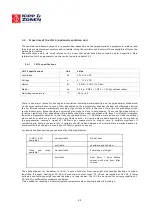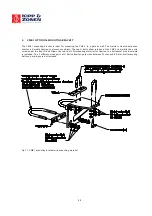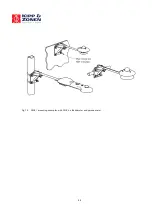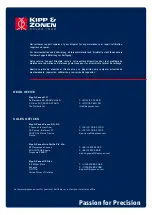
25
2.4
Properties of the CNF 4 (optional) ventilation unit
The ventilator and heaters purpose is to prevent dew deposition on the pyrgeometer and pyrgeometer window, and
thus increase measurement accuracy and reliability. Using the ventilator and heater will have negligible effect on the
pyranometer reading.
Generally these errors are small relative to the errors that would have been caused by water deposition. More
information for the pyrgeometer on this can be found in chapter 2.3.2
2.4.1
CNF 4 specifications
CNF 4 specifications
Unit
Value
Ventilation
W
5 W @ 12 VDC
Voltage
V
8 … 13.5 VDC
Heater
W
10 W @ 12 VDC (15 Ohm)
Weight
kg
0.5 kg (CNR 4 + CNF 4 = 1.35 kg)
without cables
Operating temperature:
°
C
-40 to +80
There is one major reason for heating and ventilation: avoiding water deposition on the pyrgeometer window and
on the pyranometer dome. In case of dew deposition on the pyrgeometer window, the dew will ultimately obstruct
the Far Infrared radiation completely, causing a signal close to zero. In the case of rain, this will probably not lead
to significant errors, because with an overcast sky the signal is close to zero anyway. The case of dew deposition is
far more significant. Dew deposition will probably take place under conditions with large Far Infrared irradiation
from the pyrgeometer detector to the clear sky, typically minus (-) 100 Watts per metre square. Under conditions
where clouds or wind are present, dew is less likely to occur. A situation where dew depositing on the window of
the pyrgeometer, causing a signal of -100 Watts per square metre to drop to zero, is certainly significant. If
ventilation and heating can avoid this, it certainly should be done because all errors that are described above are
much smaller than the gain in accuracy of 100 Watts per metre square.
For decisions about heating you can make the following diagram:
12 VDC, 6 VA
available?
not available
Do not heat
available
consider options below
Clock
and
relay
available?
not available
heat all day, all night
available
heat from 1 hour before
sunset until one hour after
sunrise.
The nominal power for the heater is 10 VA. In case of snow or frost you might also consider heating at a higher
level than the usual. Heating at 20 VA will melt snow in most cases. 20 VA can be reached at 24 Volt. If lower
voltage is available, you might consider heating at a lower power. The 10 VA is designed for extreme conditions. 5
VA (at 6V) is sufficient for moderate conditions.
Time needed for reaching a stable instrument temperature when heating is about 60 minutes.












































